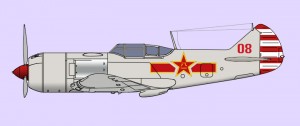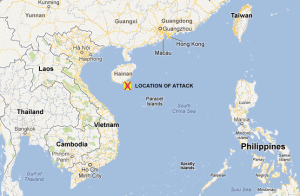Published July 26, 2012
In 1954, July 26 marked the first public news reports of and, concurrently, the final military aerial action of the Hainan Incident. Little known today, the Hainan Incident set the stage for the international isolation of China from the United Nations and the world community. Three days earlier, on July 23, two Soviet-built, propeller-driven Lavochkin LA-7 fighters with the Chinese People’s Liberation Army Air Force (PLAAF), ruthlessly attacked and shot down a Cathay Pacific Douglas C-54 Skymaster that had been converted to civilian airline service. What would follow would be a miraculous and heroic tale of piloting and rescue that is almost unsurpassed in its intensity and heroism. This is the first of a three part story about the Hainan Incident.
Cathay Pacific Comes Under Fire
On a regularly scheduled flight, a Cathay Pacific airliner (registration VR-HEU) had departed Bangkok, Thailand over four hours before. The plane was flown by a British crew headed by Captain Philip P. Blown with copilot Cedrick W. Carlton and Radio Officer Steven Wong, as well as three cabin attendants filling out the ranks of the flight crew. The airliner carried 13 passengers, one of which was an off-duty Cathay Pacific Flight Engineer, George H. Cattanach. The passengers included three young children (two boys and a girl) who were traveling with their parents, the entire Parish family of Texas.

The airliner was flying at 9,000 feet in international airspace heading to British-held Hong Kong. As the plane neared Hainan Island, at approximately 18° 06′ N, 110° 06′ E, two PLAAF fighter planes appeared and closed rapidly from the airliners 4 o’clock aspect (behind and to the right). At 2330 GMT, they took station to either side of the airliner — one behind and to the left side 150 feet above and the other behind and to the right side of the aircraft. Whether the Chinese pilots mistook the Cathay Pacific aircraft for a Taiwan-based military aircraft remains a Chinese government secret even to this day, though that seems hard to believe given clear markings that included a large British flag on the tail and the airline’s brand name written on the plane’s fuselage in large cursive letters. Regardless, at 2344 GMT, the two Chinese pilots suddenly commenced firing using incendiary bullets and cannon rounds.
Passenger Peggy Thorburn would recall the event 55 years later in an interview:
“Tracer bullets were flying in all directions. Everything had happened so quickly there was no panic amongst the passengers…. Thinking back, I feel certain that some were killed as they slept and it seems a miracle that anyone survived the stream of bullets which were coming from the two fighters…. The air in the cabin reeked of cordite and smoke. Through the porthole I could see the wing in an angry mass of flames.”
Extraordinary Flying by the Airline Captain
What transpired next was an extraordinary example of flying skill by Captain Phil Blown, a former RAAF fighter pilot from World War II. The first attack came as a surprise and in quick order the Chinese fighter planes had shot the no. 4 engine, igniting the fuel tank and aux tank behind in the wing. They also damaged the no.1 engine on the left wing, setting it afire as well. Along the fuselage, huge 12-18 inch gashes appeared as the LA-7’s gunfire sliced through the thin aluminum skin, hitting some of the passengers. In the cockpit, enemy fire came through the center of the aisle from behind and hit the boost, pressure and fuel gauges in front of the throttle stack between the two men.
With the wing ablaze, Captain Blown pushed the plane into dive to evade. Outclassed in maneuverability by the two fighter planes, there wasn’t a lot he could do — and he was completely alone in an unarmed, unarmored airliner. Copilot Cedric Carlton called for blankets to be given to the surviving passengers to put behind the seats as minimal defense against the attacking fighter’s bullets.

Captain Blown continued to descend through 5,000 feet as the airspeed built to 350 mph. The LA-7s were much faster, however, and quickly closed for another attack, this time shooting out the plane’s rudder controls. Steven Wong, the radioman, declared a Mayday, but before he could describe the situation in greater detail, the Chinese fighters shot away the radio antenna in a chance hit.
Captain Blown again turned the Cathay Pacific C-54 Skymaster, this time banking hard left and right as he attempted to turn out of the line of fire. All the while, he continued his rapid descent. The LA-7s would not be thrown off this time and they boxed the plane in — when Captain Blown turned to one side, the fighter on the opposite side would turn in to fire at the aircraft from behind. Again and again, the two Chinese fighters would attack as Captain Blown maneuvered as best he could.
“Captain Blown took evasive action, swinging the plane from side to side,” Valerie Parish, at the time a six year old passenger, would recall years later. “The fighter planes had us in a cross fire. Each time he did so the fighter on the side opposite to the way he was heading fired a burst of heavy machine gun fire into the plane, which was going down at about 350 mph. Hand luggage was toppling from the shelves above the seats. The cabin was filled with smoke from the burning cordite, it was hard to breath. The noise, the people, the smoke, the fear, at any minute the plane was expected to blow apart.
One of the LA-7’s shot off the right aileron and with that, the plane began an uncontrolled right turn. In the cockpit, the fast-thinking Captain Blown rammed the power forward on the no.3 engine on the right wing and simultaneously shut down the no.1 and no.2 engines on the left wing. With the assymetrical power from the no.3 engine only, Captain Blown was able to arrest the uncontrolled right turn and regain control of the aircraft. Meanwhile, the no.4 engine continued to blaze as the airliner trailed black smoke and fire. Running out of options, Captain Blown made a final dive for the water as the two Chinese LA-7s began firing once again.
As he descended, he realized that the waves below topped 10 feet with whitecaps. Ditching the aircraft into seas that intense would likely be fatal — and he was running out of options.
One More Bit of Aviation History
Over the years, many civilian airliners and aircraft have come under fire from military planes. Types downed range from a Boeing 747 Jumbo Jet from Korean Air Lines Flight (KAL 007) that was shot down by the Soviets off of Sakhalin Island, to a small de Havilland DH.89 Dragon Rapide that was shot down by the Israeli Air Force in September 1948. In addition, many other small aircraft have been downed over the years. Typically, the aggressor claims some sort of violation of airspace or territory to “justify” the attack. However, no matter what the claims made, there are simply no circumstances under accepted international law that allow a civilian aircraft to be justifiably shot down. The aircraft can be intercepted and forced to land, diverted to fly to other countries or escorted clear of airspace, among other options. Sadly, given the state of international law, many countries simply do not care.
